High-Frequency Observations of Cyanobacterial Blooms in Lake Taihu (China) from FY-4B/AGRI
Abstract
:1. Introduction
2. Materials and Methods
2.1. Study Region
2.2. Advanced Geosynchronous Radiation Imager (AGRI) Data
2.3. Atmospheric Correction (AC)
2.4. Cross-Validation of AGRI Rs with the Advanced Himawari Imager (AHI)
2.5. Algorithm for Detection of Cyanobacterial Blooms
3. Results
3.1. Performance of Atmospheric Correction on AGRI NDVI Calculation
3.2. Evaluation of Spatial Patterns from AGRI
3.3. Spatiotemporal Variation in Cyanobacteria Blooms from AGRI
4. Discussion
4.1. Possible Environmental Factors Influencing the Diurnal Variation in Cyanobacterial Blooms
4.2. Advantages, Limitations, and Future Works
5. Conclusions
Author Contributions
Funding
Data Availability Statement
Acknowledgments
Conflicts of Interest
References
- Backer, L.C.; Manassaram-Baptiste, D.; LePrell, R.; Bolton, B. Cyanobacteria and algae blooms: Review of health and environmental data from the harmful algal bloom-related illness surveillance system (HABISS) 2007–2011. Toxins 2015, 7, 1048–1064. [Google Scholar] [CrossRef] [PubMed] [Green Version]
- Hughes, S.E.; Marion, J.W. Cyanobacteria Growth in Nitrogen-&Phosphorus-Spiked Water from a Hypereutrophic Reservoir in Kentucky, USA. J. Environ. Prot. 2021, 12, 75–89. [Google Scholar]
- Wang, K.; Razzano, M.; Mou, X.Z. Cyanobacterial blooms alter the relative importance of neutral and selective processes in assembling freshwater bacterioplankton community. Sci. Total Environ. 2020, 706, 135724. [Google Scholar] [CrossRef]
- Wang, K.; Mou, X.; Cao, H.; Struewing, I.; Allen, J.; Lu, J. Co-occurring microorganisms regulate the succession of cyanobacterial harmful algal blooms. Environ. Pollut. 2021, 288, 117682. [Google Scholar] [CrossRef]
- Zhang, Q.; Zhang, Z.; Lu, T.; Peijnenburg, W.J.G.M.; Gillings, M.; Yang, X.; Chen, J.; Penuelas, J.; Zhu, Y.G.; Zhou, N.Y.; et al. Cyanobacterial blooms contribute to the diversity of antibiotic-resistance genes in aquatic ecosystems. Commun. Biol. 2020, 3, 737. [Google Scholar] [CrossRef]
- Schmale, D.G.; Ault, A.P.; Saad, W.; Scott, T.D.; Westwrick, J.A. Perspectives on Harmful Algal Blooms (HABs) and the Cyberbiosecurity of Freshwater Systems. Front. Bioeng. Biotechnol. 2019, 7, 128. [Google Scholar] [CrossRef] [PubMed] [Green Version]
- O’Neila, J.M.; Davisb, T.W.; Burfordb, M.A.; Gobler, C.J. The rise of harmful cyanobacteria blooms: The potential roles of eutrophication and climate change. Harmful Algae 2012, 14, 313–334. [Google Scholar] [CrossRef]
- Paerl, H.W.; Otten, T.G. Harmful Cyanobacterial Blooms: Causes, Consequences, and Controls. Microb. Ecol. 2013, 65, 995–1010. [Google Scholar] [CrossRef]
- Ho, J.C.; Michalak, A.M.; Pahlevan, N. Widespread global increase in intense lake phytoplankton blooms since the 1980s. Nature 2019, 574, 667–670. [Google Scholar] [CrossRef]
- Zhao, H.; Li, J.; Yan, X.; Fang, S.; Du, Y.; Xue, B.; Yu, K.; Wang, C. Monitoring Cyanobacteria Bloom in Dianchi Lake Based on Ground-Based Multispectral Remote-Sensing Imaging: Preliminary Results. Remote Sens. 2021, 13, 3970. [Google Scholar] [CrossRef]
- Wynne, T.T.; Stumpf, R.P.; Pokrzywinski, K.L.; Litaker, R.W.; De Stasio, B.T.; Hood, R.R. Cyanobacterial Bloom Phenology in Green Bay Using MERIS Satellite Data and Comparisons with Western Lake Erie and Saginaw Bay. Water 2022, 14, 2636. [Google Scholar] [CrossRef]
- Hang, X.; Li, Y.; Li, X.; Xu, M.; Sun, L. Estimation of chlorophyll-a concentration in Lake Taihu from Gaofen-1 wide-field-of-view data through a machine learning trained algorithm. J. Meteor. Res. 2022, 36, 208–226. [Google Scholar] [CrossRef]
- Mozafari, Z.; Noori, R.; Siadatmousavi, S.M.; Afzalimehr, H.; Azizpour, J. Satellite-Based Monitoring of Eutrophication in the Earth’s Largest Transboundary Lake. Geohealth 2023, 7, e2022GH000770. [Google Scholar] [CrossRef] [PubMed]
- Modabberi, A.; Noori, R.; Madani, K.; Ehsani, A.H.; Mehr, A.D.; Hooshyaripor, F.; Kløve, B. Caspian Sea is eutrophying: The alarming message of satellite data. Environ. Res. Lett. 2020, 15, 124047. [Google Scholar] [CrossRef]
- Ho, J.C.; Michalak, A.M. Challenges in tracking harmful algal blooms: A synthesis of evidence from Lake Erie. J. Great Lakes Res. 2015, 41, 317–325. [Google Scholar] [CrossRef] [Green Version]
- Ho, J.C.; Stumpf, R.P.; Bridgeman, T.B.; Michalak, A.M. Using Landsat to extend the historical record of lacustrine phytoplankton blooms: A lake Erie case study. Remote Sens. Environ. 2017, 191, 273–285. [Google Scholar] [CrossRef]
- Shi, K.; Zhang, Y.; Qin, B.; Zhou, B. Remote sensing of cyanobacterial blooms in inland waters: Present knowledge and future challenges. Sci. Bull. 2019, 64, 1540–1556. [Google Scholar] [CrossRef] [Green Version]
- Zhang, Y.; Shi, K.; Cao, Z.; Lai, L.; Geng, J.; Yu, K.; Zhan, P.; Liu, Z. Effects of satellite temporal resolutions on the remote derivation of trends in phytoplankton blooms in inland waters. ISPRS J. Photogramm. Remote Sens. 2022, 191, 188–202. [Google Scholar] [CrossRef]
- Chen, X.; Shang, S.; Lee, Z.; Qi, L.; Yan, J.; Li, Y. High-frequency observation of floating algae from AHI on Himawari-8. Remote Sens. Environ. 2019, 227, 151–161. [Google Scholar] [CrossRef]
- Zhang, P.; Zhu, L.; Tang, S.; Gao, L.; Chen, L.; Zheng, W.; Han, X.; Chen, J.; Shao, J. General Comparison of FY-4A/AGRI With Other GEO/LEO Instruments and Its Potential and Challenges in Non-meteorological Applications. Front. Earth Sci. 2019, 6, 224. [Google Scholar] [CrossRef] [Green Version]
- Wang, M.; Zheng, W.; Liu, C. Application of Himawari-8 data with high-frequency observation for Cyanobacteria bloom dynamically monitoring in Lake Taihu. J. Lake Sci. 2017, 29, 1043–1053. [Google Scholar]
- Hu, C.M.; Muller-Karger, F.E.; Taylor, C.; Carder, K.L.; Kelble, C.; Johns, E.; Heil, C.A. Red tide detection and tracing using MODIS fluorescence data: A regional example in SW Florida coastal waters. Remote Sens. Environ. 2005, 97, 311–321. [Google Scholar] [CrossRef]
- Wang, M.; Shi, W.; Tang, J. Water property monitoring and assessment for China’s inland Lake Taihu from MODIS-Aqua measurements. Remote Sens. Environ. 2011, 115, 841–854. [Google Scholar] [CrossRef]
- Lai, L.; Zhang, Y.C.; Jing, Y.Y.; Liu, Z.M. Research progress on remote sensing monitoring of phytoplankton in eutrophic water. J. Lake Sci. 2021, 33, 1299–1314. [Google Scholar] [CrossRef]
- Chen, Y.; Dai, J.F. Extraction methods of cyanobacteria bloom in Lake Taihu based on RS data. J. Lake Sci. 2008, 20, 179–183. [Google Scholar]
- Qi, L.; Hu, C.M.; Lu, Y.C.; Ma, R.H. Spectral analysis and identification of floating algal blooms in oceans and lakes based on HY-1C/D CZI observations. Natl. Remote Sens. Bull. 2023, 27, 157–170. [Google Scholar]
- Baret, F.; Weiss, M.; Lacaze, R.; Camacho, F.; Makhmara, H.; Pacholcyzk, P.; Smets, B. GEOV1: LAI and FAPAR essential climate variables and FCOVER global time series capitalizing over existing products. Part 1: Principles of development and production. Remote Sens. Environ. 2013, 137, 299–309. [Google Scholar] [CrossRef]
- Jia, K.; Liang, S.; Gu, X.; Baret, F.; Wei, X.; Wang, X.; Yao, Y.; Yang, L.; Li, Y. Fractional vegetation cover estimation algorithm for Chinese GF-1 wide field view data. Remote Sens. Environ. 2016, 177, 184–191. [Google Scholar] [CrossRef]
- Riihimäki, H.; Luoto, M.; Heiskanen, J. Estimating fractional cover of tundra vegetation at multiple scales using unmanned aerial systems and optical satellite data. Remote Sens. Environ. 2019, 224, 119–132. [Google Scholar] [CrossRef]
- Shi, K.; Zhang, Y.; Zhou, Y.; Liu, X.; Zhu, G.; Qin, B.; Gao, G. Long-term MODIS observations of cyanobacterial dynamics in Lake Taihu: Responses to nutrient enrichment and meteorological factors. Sci. Rep. 2017, 7, 40326. [Google Scholar] [CrossRef] [Green Version]
- Cai, L.L.; Zhu, G.W.; Zhu, M.Y.; Yang, G.J.; Zhao, L.L. Succession of phytoplankton structure and its relationship with algae bloom in littoral zone of Meiliang Bay, Taihu Lake. Ecol. Sci. 2012, 31, 345–351. [Google Scholar]
- Kong, F.X.; Ma, R.H.; Gao, J.F.; Wu, X.D. The theory and practice of prevention, forecast and warning on cyanobacteria bloom in Lake Taihu. J. Lake Sci. 2009, 21, 314–328. [Google Scholar]
- Gordon, H.R.; Wang, M. Retrieval of water-leaving radiance and aerosol optical thickness over the oceans with SeaWiFS: A preliminary algorithm. Appl. Opt. 1994, 33, 443–452. [Google Scholar] [CrossRef] [PubMed]
- Pahlevan, N.; Mangin, A.; Balasubramanian, S.V.; Smith, B.; Alikas, K.; Arai, K.; Barbosa, C.; Bélanger, S.; Binding, C.; Bresciani, M.; et al. ACIX-Aqua: A global assessment of atmospheric correction methods for Landsat-8 and Sentinel-2 over lakes, rivers, and coastal waters. Remote Sens. Environ. 2021, 258, 112366. [Google Scholar] [CrossRef]
- Fan, Y.; Li, W.; Gatebe, C.K.; Jamet, C.; Zibordi, G.; Schroeder, T.; Stamnes, K. Atmospheric correction over coastal waters using multilayer neural networks. Remote Sens. Environ. 2017, 199, 218–240. [Google Scholar] [CrossRef]
- Vanhellemont, Q.; Ruddick, K. Advantages of high quality SWIR bands for ocean colour processing: Examples from Landsat-8. Remote Sens. Environ. 2015, 161, 89–106. [Google Scholar] [CrossRef] [Green Version]
- Shard, C.; Ashwin, G.; Aswathy, V.K.; Arvind, S.; Singh, R.P. Remote sensing of inland water quality: A hyperspectral perspective. In Hyperspectral Remote Sensing; Elsevier: Amsterdam, The Netherlands, 2020; pp. 197–219. [Google Scholar]
- Vermote, E.F.; Tanré, D.; Deuze, J.L.; Herman, M.; Morcette, J.J. Second simulation of the satellite signal in the solar spectrum, 6S: An overview. IEEE Trans. Geosci. Remote Sens. 1997, 35, 675–686. [Google Scholar] [CrossRef] [Green Version]
- Han, X.; Wang, F.; Han, Y. Fengyun-3D MERSI True Color Imagery Developed for Environmental Applications. J. Meteor. Res. 2019, 33, 914–924. [Google Scholar] [CrossRef]
- Ding, S.; Weng, F. Influences of physical processes and parameters on simulations of TOA radiance at UV wavelengths: Implications for satellite UV instrument validation. J. Meteor. Res. 2019, 33, 264–275. [Google Scholar] [CrossRef]
- Li, S.; Han, X.; Weng, F. Monitoring Land Vegetation from Geostationary Satellite Advanced Himawari Imager (AHI). Remote Sens. 2022, 14, 3817. [Google Scholar] [CrossRef]
- Feng, L. Key issues in detecting lacustrine cyanobacterial bloom using satellite remote sensing. J. Lake Sci. 2021, 33, 647–652. [Google Scholar]
- Matthews, M.W.; Bernard, S.; Robertson, L. An algorithm for detecting trophic status (chlorophyll-a), cyanobacterial-dominance, surface scums and floating vegetation in inland and coastal waters. Remote Sens. Environ. 2012, 124, 637–652. [Google Scholar] [CrossRef]
- Han, X.Z.; Wu, C.Y.; Zheng, W.; Sun, L. Satellite remote sensing of Cyanophyte using observed spectral measurements over the Taihu lake. J. App. Met. Sci. 2012, 21, 724–730. [Google Scholar]
- Duan, H.T.; Zhang, S.X.; Zhang, Y.Z. Cyanobacteria bloom monitoring with remote sensing in Lake Taihu. J. Lake Sci. 2008, 20, 145–152. [Google Scholar]
- Tucker, C.J. Red and photographic infrared linear combinations for monitoring vegetation. Remote Sens. Environ. 1979, 8, 127–150. [Google Scholar] [CrossRef] [Green Version]
- Hu, C. A novel ocean color index to detect floating algae in the global oceans. Remote Sens. Environ. 2009, 113, 2118–2129. [Google Scholar] [CrossRef]
- Zong, J.-M.; Wang, X.-X.; Zhong, Q.-Y.; Xiao, X.-M.; Ma, J.; Zhao, B. Increasing Outbreak of Cyanobacterial Blooms in Large Lakes and Reservoirs under Pressures from Climate Change and Anthropogenic Interferences in the Middle–Lower Yangtze River Basin. Remote Sens. 2019, 11, 1754. [Google Scholar] [CrossRef] [Green Version]
- Tu, Y.; Jia, K.; Wei, X.; Yao, Y.; Xia, M.; Zhang, X.; Jiang, B. A Time-Efficient Fractional Vegetation Cover Estimation Method Using the Dynamic Vegetation Growth Information from Time Series GLASS FVC Product. IEEE Geosci. Remote Sens. Lett. 2020, 17, 1672–1676. [Google Scholar] [CrossRef]
- Wang, J.; Yan, Q.; Tan, X.L.; Zou, Y.J. Vegetation Coverage Dynamics and Its Driving Factors in Inner Mongolia Based on FVC Information Entropy. Forest Res. Manag. 2019, 159–167. [Google Scholar]
- Yan, K.; Gao, S.; Chi, H. Evaluation of the Vegetation-Index-Based Dimidiate Pixel Model for Fractional Vegetation Cover Estimation. IEEE Geosci. Remote Sens. 2021, 99, 1–14. [Google Scholar] [CrossRef]
- Tang, L.; He, M.; Li, X. Verification of fractional vegetation coverage and NDVI of desert vegetation via UAVRS technology. Remote Sens. 2020, 12, 1742. [Google Scholar] [CrossRef]
- Lin, Q.; Hu, C.; Visser, P.M.; Ma, R. Diurnal changes of cyanobacteria blooms in taihu lake as derived from goci observations. Limnol. Oceanogr. 2018, 63, 1711–1726. [Google Scholar]
- Li, W.; Qin, B.Q. Dynamics of spatiotemporal heterogeneity of cyanobacterial blooms in large eutrophic Lake Taihu, China. Hydrobiologia 2019, 833, 81–93. [Google Scholar] [CrossRef]
- Qin, B.; Yang, G.; Ma, J.; Wu, T.; Li, W.; Liu, L.; Deng, J.; Zhou, J. Spatiotemporal Changes of Cyanobacterial Bloom in Large Shallow Eutrophic Lake Taihu, China. Front. Microbiol. 2018, 9, 451. [Google Scholar] [CrossRef] [PubMed] [Green Version]
- Li, Y.C.; Xie, X.P.; Hang, X.; Zhu, X.L.; Huang, S.; Jing, Y.S. Analysis of wind field features causing cyanobacteria bloom in Taihu Lake combined with remote sensing methods. China Environ. Sci. 2016, 36, 525–533. [Google Scholar]
- Hu, C.; Lee, Z.; Ma, R.; Yu, K.; Li, D.; Shang, S. Moderate resolution imaging spectroradiometer (MODIS) observations of cyanobacteria blooms in Taihu Lake, China. J. Geophys. Res. Ocean. 2010, 115, 303–306. [Google Scholar] [CrossRef] [Green Version]
- Xu, J.P.; Zhang, B.; Li, F.; Song, K.S.; Wang, Z.M. Detecting modes of cyanobacteria bloom using MODIS data in Lake Taihu. J. Lake Sci. 2008, 20, 191–195. [Google Scholar]
- Xie, G.Q.; Li, M.; Lu, W.K.; Zhou, W.M.; Yu, L.X.; Li, F.R.; Yang, S.P. Spectral features, remote sensing identification and breaking-out meteorological conditions of algal bloom in Lake Dianchi. J. Lake Sci. 2010, 22, 327–336. [Google Scholar]
- Pan, X.; Yang, Z.; Yang, Y.B.; Sun, Y.X.; Liu, S.Y.; Xie, W.Y.; Li, T.T. Comparison and applicability analysis of methods for extracting cyanobacteria from Lake Taihu based on GF-6 data. J. Lake Sci. 2022, 34, 1866–1876. [Google Scholar]
- Bresciani, M.; Adamo, M.; Carolis, G.D.; Matta, E.; Pasquariello, G.; Vaičiūtė, D.; Giardino, C. Monitoring blooms and surface accumulation of cyanobacteria in the Curonian Lagoon by combining MERIS and ASAR data. Remote Sens. Environ. 2014, 146, 124–135. [Google Scholar] [CrossRef]
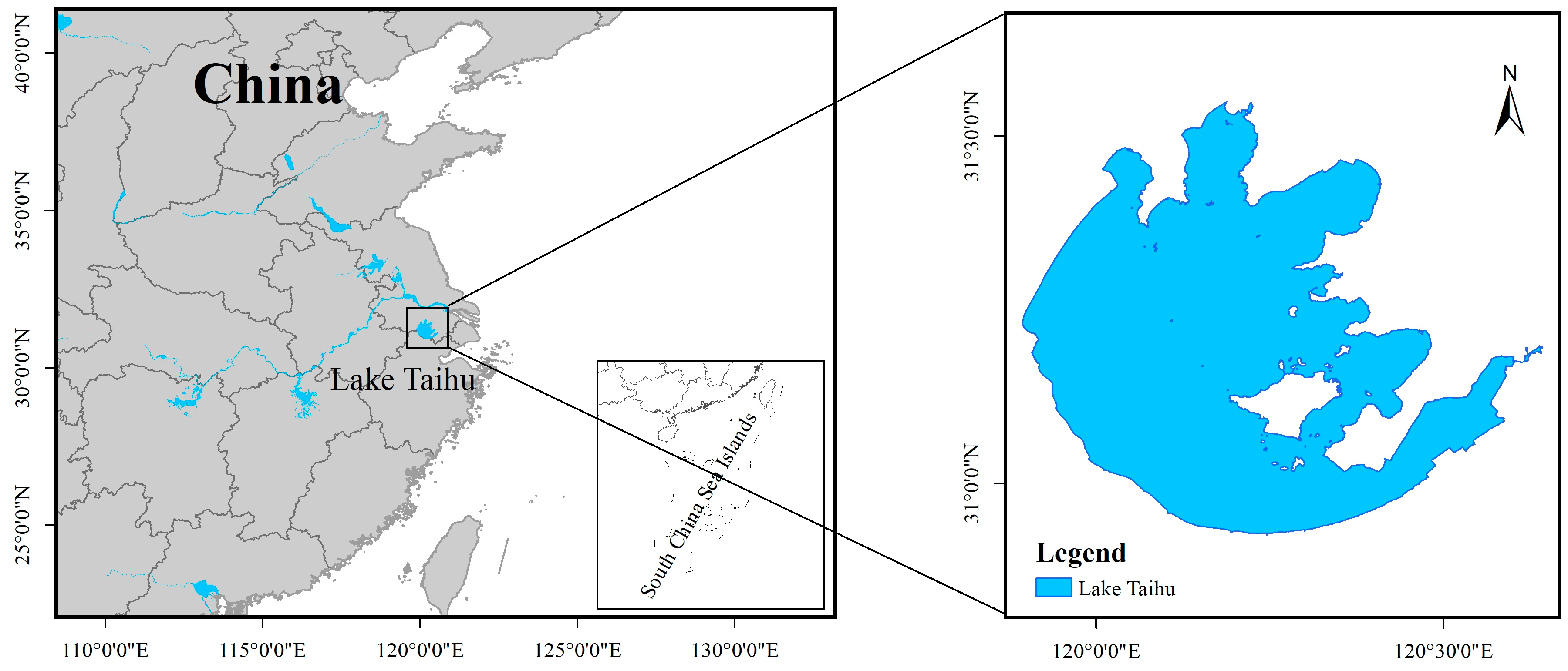
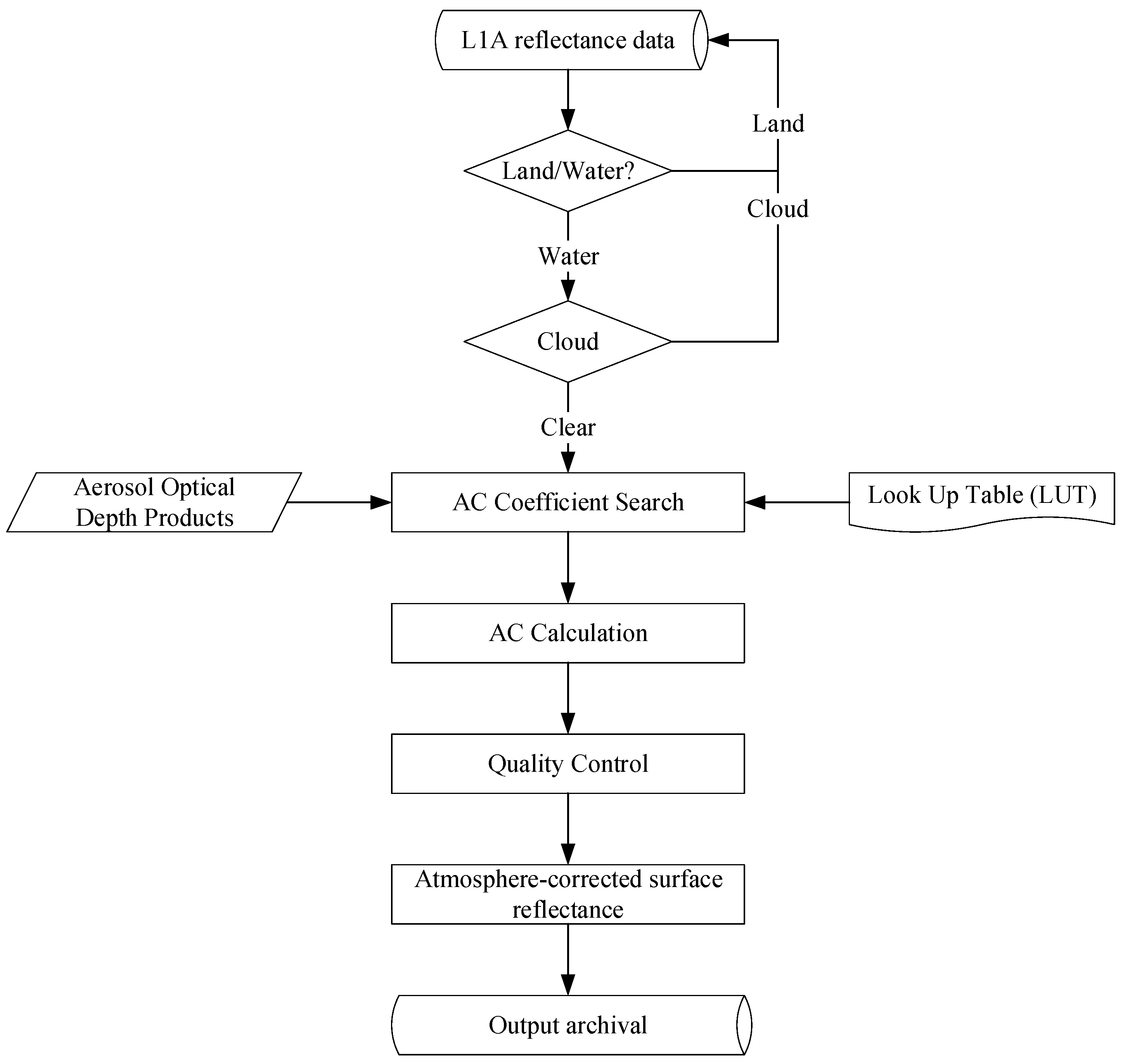
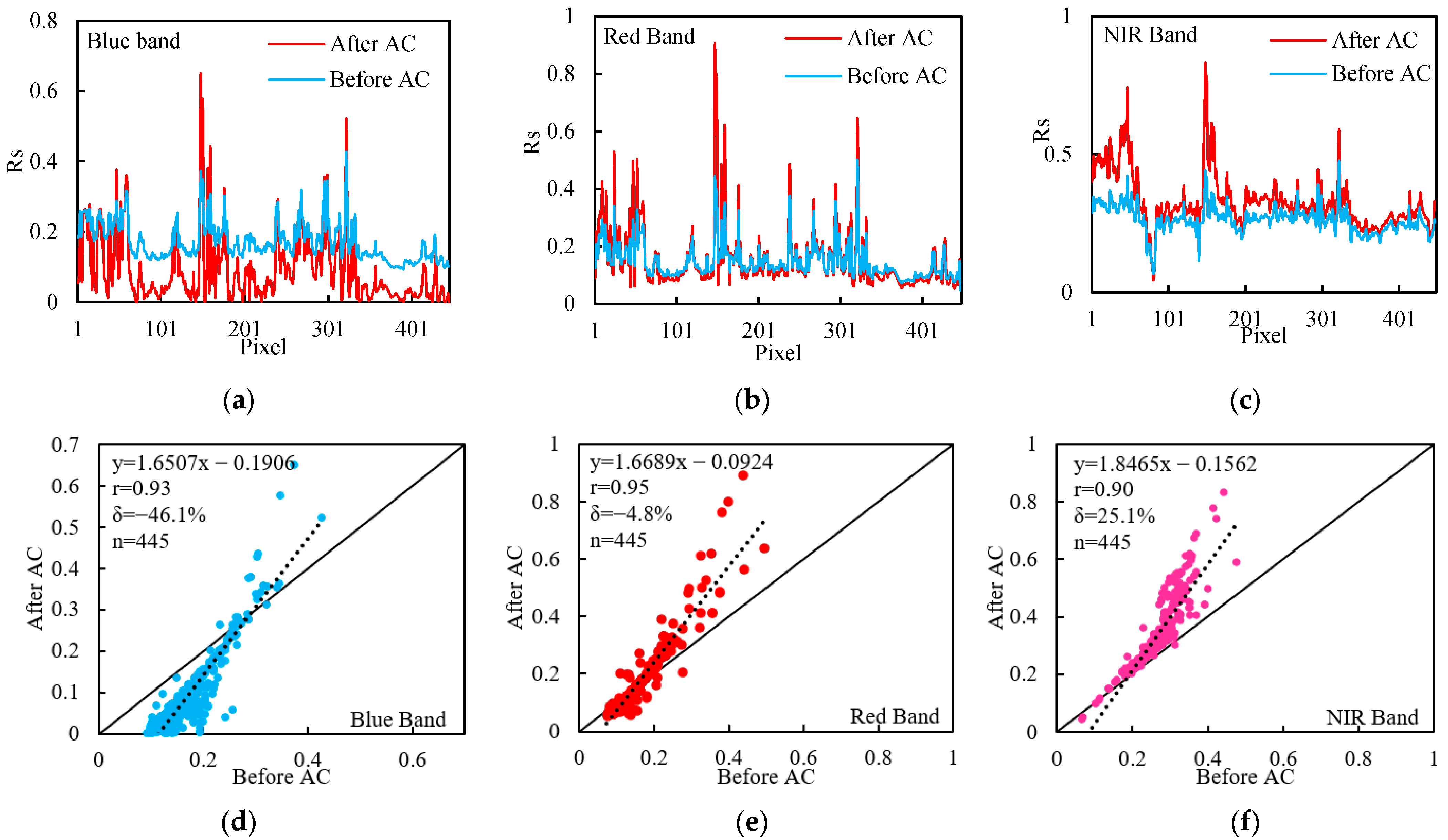


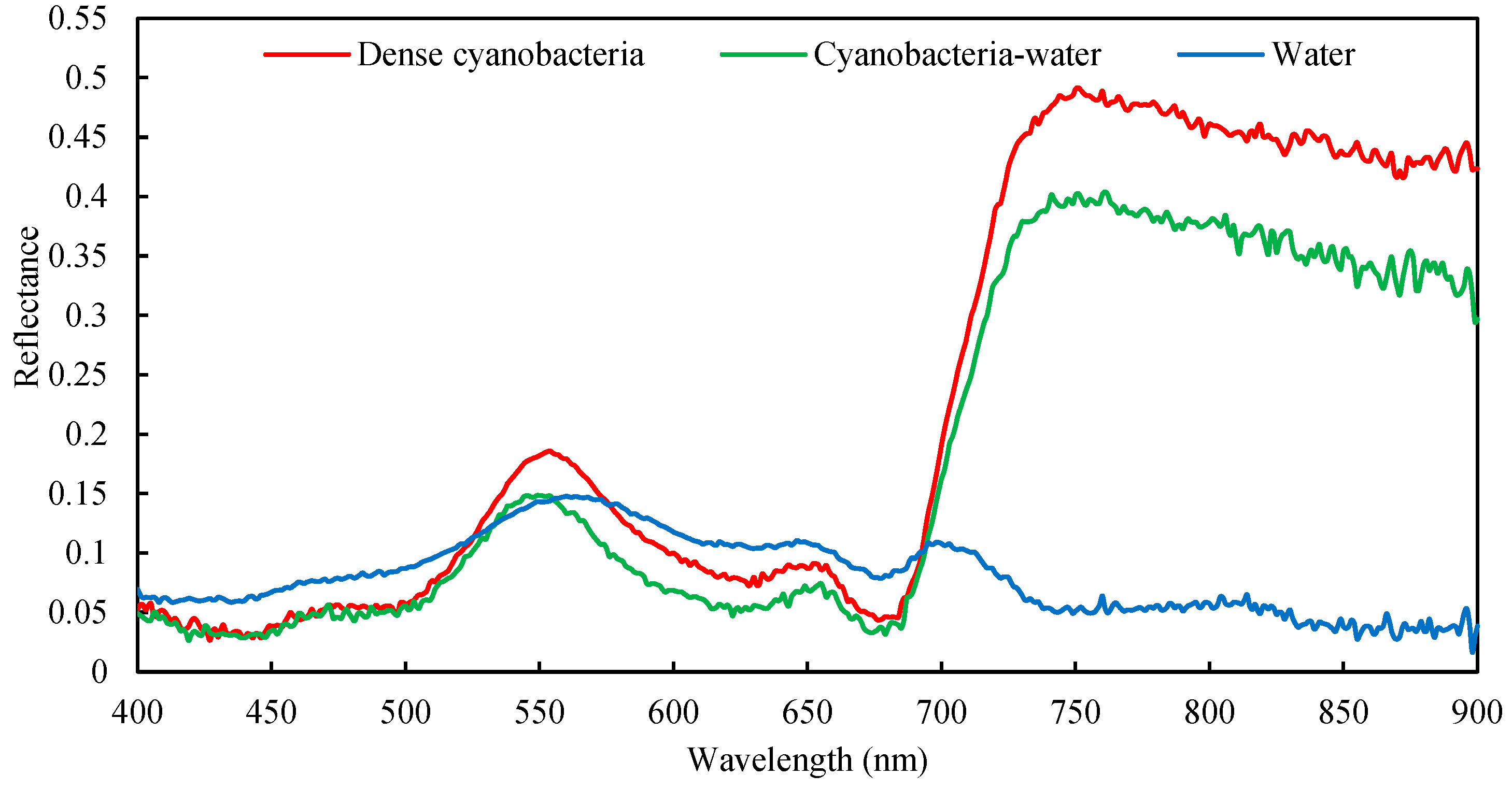
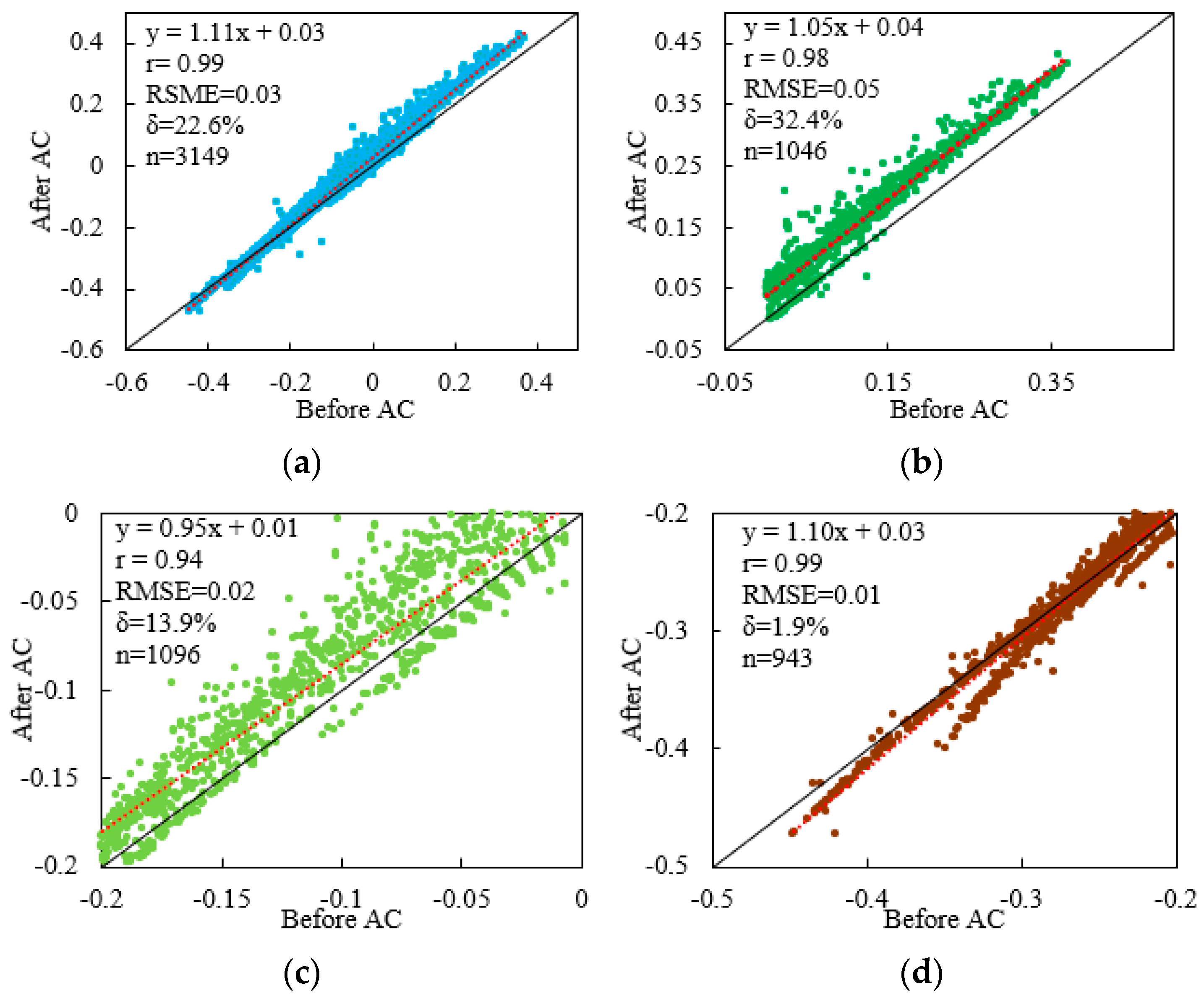
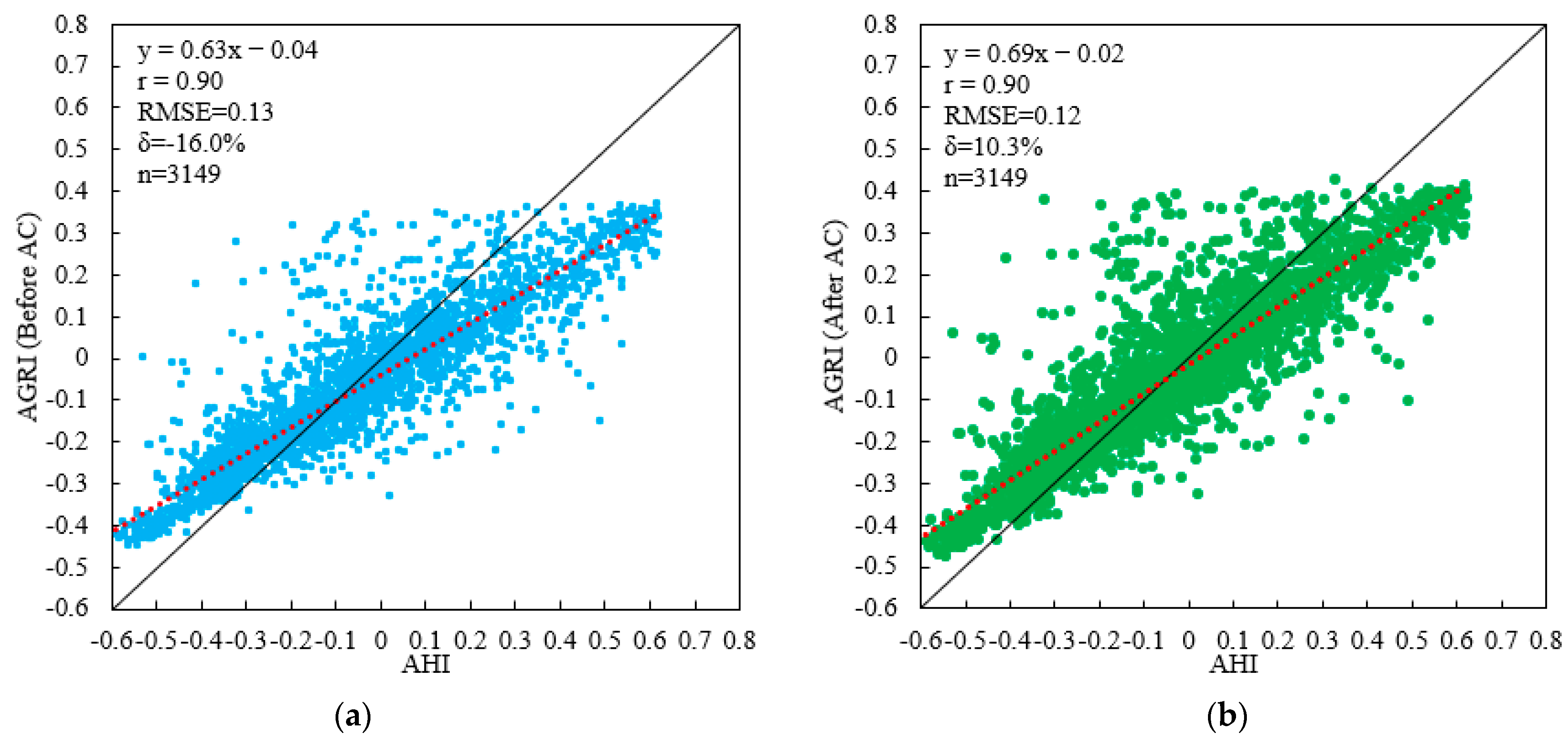





| Bands | Central Wavelength (μm) | Bandwidth (μm) | Spatial Resolution (km) | SNR |
|---|---|---|---|---|
| 1 | 0.47 | 0.45~0.49 | 1 | S/N ≥ 90 |
| 2 | 0.65 | 0.55~0.75 | 0.5 | S/N ≥ 150 |
| 3 | 0.825 | 0.75~0.90 | 1 | S/N ≥ 200 |
| 4 | 1.379 | 1.371~1.386 | 2 | S/N ≥ 120 |
| 5 | 1.61 | 1.58~1.64 | 2 | S/N ≥ 200 |
| 6 | 2.225 | 2.10~2.35 | 2 | S/N ≥ 200 |
| 7 | 3.75 | 3.50~4.00 (high) | 2 | ≤0.7 K (315 K) |
| 8 | 3.75 | 3.50~4.00 (low) | 4 | 0.2 K (300 K) |
| 9 | 6.25 | 5.80~6.70 | 4 | 0.2 K (300 K) |
| 10 | 6.95 | 6.75~7.15 | 4 | 0.25 K (300 K) |
| 11 | 7.42 | 7.24~7.60 | 4 | 0.25 K (300 K) |
| 12 | 8.55 | 8.3~8.8 | 4 | 0.2 K (300 K) |
| 13 | 10.80 | 10.30~11.30 | 4 | 0.2 K (300 K) |
| 14 | 12.00 | 11.50~12.50 | 4 | 0.2 K (300 K) |
| 15 | 13.3 | 13.00~13.60 | 4 | 0.5 K (300 K) |
Disclaimer/Publisher’s Note: The statements, opinions and data contained in all publications are solely those of the individual author(s) and contributor(s) and not of MDPI and/or the editor(s). MDPI and/or the editor(s) disclaim responsibility for any injury to people or property resulting from any ideas, methods, instructions or products referred to in the content. |
© 2023 by the authors. Licensee MDPI, Basel, Switzerland. This article is an open access article distributed under the terms and conditions of the Creative Commons Attribution (CC BY) license (https://creativecommons.org/licenses/by/4.0/).
Share and Cite
Hang, X.; Li, X.; Li, Y.; Zhu, S.; Li, S.; Han, X.; Sun, L. High-Frequency Observations of Cyanobacterial Blooms in Lake Taihu (China) from FY-4B/AGRI. Water 2023, 15, 2165. https://doi.org/10.3390/w15122165
Hang X, Li X, Li Y, Zhu S, Li S, Han X, Sun L. High-Frequency Observations of Cyanobacterial Blooms in Lake Taihu (China) from FY-4B/AGRI. Water. 2023; 15(12):2165. https://doi.org/10.3390/w15122165
Chicago/Turabian StyleHang, Xin, Xinyi Li, Yachun Li, Shihua Zhu, Shengqi Li, Xiuzhen Han, and Liangxiao Sun. 2023. "High-Frequency Observations of Cyanobacterial Blooms in Lake Taihu (China) from FY-4B/AGRI" Water 15, no. 12: 2165. https://doi.org/10.3390/w15122165




